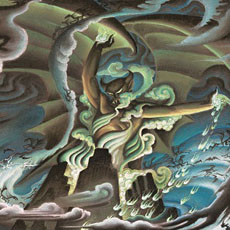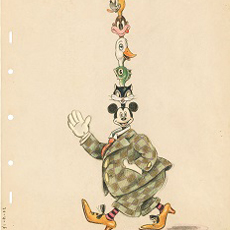 Two years before Snow White And The Seven Dwarfs, and four months after the release of the first Mickey Mouse short in color, The Band Concert, Walt Disney traveled to Europe and became conscious of the extent of his international fame. His wife, Lillian, his brother, Roy, and his sister-in-law, Edna went with him. They were feted by nobility, by political elites, and by the most prominent European artists, among them H.G. Wells and Louis Lumière. They came back with more than three hundred books, which would remain sources of inspiration at the Disney Studio for years to come. They came back with a broader view of the world. And Walt came back with ideas which would infuse his creations for decades. All in all, it was a seminal trip at the height of Disney’s Golden Age. But did Walt really receive a medal from the League Of Nations during his stay in Paris? Did he really meet Benito Mussolini while in Rome? Was the trip pure pleasure or did it involve much business? How were the Disney businesses structured in Europe at the time?
Two years before Snow White And The Seven Dwarfs, and four months after the release of the first Mickey Mouse short in color, The Band Concert, Walt Disney traveled to Europe and became conscious of the extent of his international fame. His wife, Lillian, his brother, Roy, and his sister-in-law, Edna went with him. They were feted by nobility, by political elites, and by the most prominent European artists, among them H.G. Wells and Louis Lumière. They came back with more than three hundred books, which would remain sources of inspiration at the Disney Studio for years to come. They came back with a broader view of the world. And Walt came back with ideas which would infuse his creations for decades. All in all, it was a seminal trip at the height of Disney’s Golden Age. But did Walt really receive a medal from the League Of Nations during his stay in Paris? Did he really meet Benito Mussolini while in Rome? Was the trip pure pleasure or did it involve much business? How were the Disney businesses structured in Europe at the time?
Author Didier Ghez is well known by anyone interested in Disney history. He has conducted Disney research since he was a teenager in the mid-1980s. His articles about the Disney parks, Disney animation, and vintage international Disneyana, as well as his many interviews with Disney artists, have appeared in Animation Journal, Animation Magazine, Disney Twenty Three, Persistence Of Vision, Storyboard, and Tomart’s Disneyana Update. He also is the co-author of Disneyland Paris – From Sketch to Reality, runs the Disney History blog, the Disney Books Network site, and serves as managing editor of the Walt’s People book series.
Using as his sources Edna and Roy’s diary of the trip, as well as hundreds of European newspaper and magazine articles released in 1935, Didier Ghez, for the first time, gives precise answers to those questions, analyzes the roots of Disney’s expansion in Europe, and lets us relive—complete with dozens of never-released photographs—the trip of a lifetime, Disney’s Grand Tour.
He kindly accepted to tell us more about the making of what is certainly to be one of the most important books on Disney history published yet.
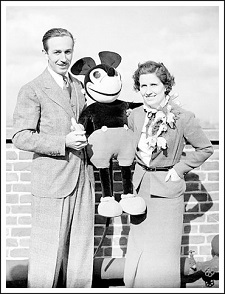 AnimatedViews: You talk about Walt Disney’s Grand Tour as “the most influential journey he ever undertook.” Would you explain why?
AnimatedViews: You talk about Walt Disney’s Grand Tour as “the most influential journey he ever undertook.” Would you explain why?
Didier Ghez: Walt and Roy’s trip to Europe took place in June and July 1935. The first Mickey cartoon in color had just been released and the release of Snow White And The Seven Dwarfs was only two years away. Walt was influenced by that trip in a million different ways:
a) He bought hundreds of books, whose stories and illustrations would influence him and his artists for years to come.
b) He became aware for the first time in a direct way how popular his creations were outside of the US.
c) He was able to check out the recently established English and French Disney subsidiaries, which served as the basis of the Disney expansion abroad.
d) He met celebrities with whom he would stay in touch for years to come and who would introduce him to many more people which opened new business and creative doors for him.
e) Finally, thanks to his tremendous memory, he stored hundreds of ideas that would be used in future projects: a maze in the UK which would appear close to twenty years later in Alice in Wonderland, a clock in Strasbourg that made its way to Disneyland, and on it goes.
This long trip was truly a turning point in his life and career and it was not just a vacation, but included a lot of very important business, too.
AV: Your main source was Roy & Edna’s journal. What is it like?
DG: In reality, I had three main sources to write this book: correspondence stored at the Walt Disney Archives, hundreds and hundreds of articles released in foreign newspapers and magazines, and Edna & Roy’s diary. The diary is about fifteen pages long, but contains entries for every day of the trip, pointing out the key things that Roy and Edna experienced. It was a great starting point to understand how the trip was structured, to know who the Disneys met and where they went, but it was only the first step in a much broader quest. The correspondence at the Disney Archives helped understand the business aspect of the trip and also contains some very human aspects, like the news about their family that Walt and Roy received during the trip, some of which was moving, some of which was hilarious. When it comes to the articles, they were probably one of the richest sources of information, with documents in English, French, German, Italian, Spanish, Portuguese, Norwegian, and even Danish to study, and some magazines released in countries as far away as Australia. All of them provided additional details to the story of the trip. Many led to fascinating discoveries.
The book is the result of an investigation process that took me close to 25 years!
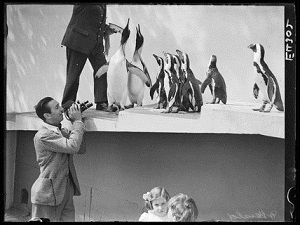
AV: Writing this book and researching about that trip wasn’t just about history. It was important to you on a personal matter. Would you explain why?
DG: To answer that question, let me quote from the book’s introduction:
“For more than twenty years, I kept hitting a brick wall.
The official history of Disney in Europe seemed to start after World War II. We all knew about the various Disney magazines which existed in the Old World in the ’30s, and we knew about the highly prized pre-World War II collectibles. That was about it. The rest of the story was not even sketchy: it remained a complete mystery. For a Disney historian born and raised in Paris this was highly unsatisfactory. I wanted to understand much more: How did it all start? Who were the men and women who helped establish and grow Disney’s presence in Europe? How many were they? Were there any talented artists among them? How did the businessmen operate? Where exactly did Disney have offices? How were those offices structured? How did Walt and Roy interact with them?
I managed to chip away at the brick wall, by learning about the existence of Disney’s first representative in Europe, William Banks Levy; by learning the name George Kamen; and by piecing together the story of some of the early Disney licensees. This was still highly unsatisfactory. We had never seen a photo of Bill Levy, there was little that we knew about George Kamen’s career, and the overall picture simply was not there.
Then, in July 2011, Diane Disney Miller, Walt Disney’s daughter, asked me a seemingly simple question: “Do you know if any photos were taken during the ‘League Of Nations’ event that my father attended during his trip to Paris in 1935?” And the solution to the great Disney European mystery started to unravel. This “simple” question from Diane proved to be anything but. It also allowed me to focus on an event, Walt’s visit to Europe in 1935, which gave me the key to the mysteries I had been investigating for twenty-three years. Remarkably, in just two years most of the answers were found.
[…]
Why did it take so long? In short, because solving the mystery meant reaching a very high level of maturity in terms of Disney knowledge and personal knowledge, as well as being helped by tools which did not exist even a few years ago.
From a personal standpoint, I had to be able to read documents in French, English, Italian, Spanish, and Portuguese, and to get help when it came to translating those in German, Swedish, and Danish. The mastery of those languages took years to achieve.
From a Disney-knowledge standpoint, I had to thoroughly understand the business history as well as the creative history of the company, I had to know who was who within the Disney corporate structure in the ’30s, and I also had to locate many documents that were extremely well hidden, like the never-released autobiographies of O.B. Johnston, Jimmy Johnson, and Mel Shaw, or the Robert Hartman Papers. Each of them contained key pieces of the jigsaw puzzle, which shed new light on the entries in Roy and Edna’s diary and on Walt and Roy’s correspondence, all of which led to a cascade of new discoveries.
Finally, I was lucky to have access to tools that historians of the past did not have at their disposal. Although researching the origins of Walt Disney – Mickey Mouse S.A. at the Registre du Commerce is still done the old-fashioned way and involves physically getting there and being locked up in the room for several hours without any digital tool, there were many instances in which access to online archives proved to be a game-changer: from the Open Library, to Gallica.bnf.fr, to the online archives of the Daily Mirror and The New York Times. In one instance, the old and the new merged in astonishing ways: when I tried to locate the address of the 1930s Italian Ministry of Press and Propaganda (to find out if Walt had actually met Benito Mussolini), I had to rely on some 1934 footage which had been posted online, in an excerpt from a 1936 book quoted in an online forum, and on Google’s StreetView! None of these tools — old and new — alone would have done the trick.
In the end, the brick wall crumbled, and I am able to lead you to the other side. I thought I was just following Walt’s footsteps—I ended up discovering a whole new Disney History continent.”
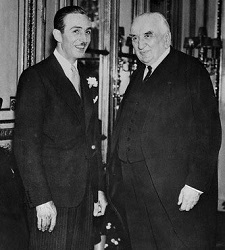
AV: From your perspective, what are the most important discoveries you made?
DG: From a historical standpoint, the most important discovery was being able to prove once and for all whether Walt had met Mussolini during the trip. Documents kept pointing in the positive direction, then in the negative one, and it took me close to two and a half years to find out what the truth was, with compelling evidence. You will have to read the book to know the answer.
From a personal standpoint the most important discovery was to find out who were the first employees to join the French Disney subsidiary before WWII and to understand how the business was actually structured in those years.
Immensely satisfying was also to unearth tens of never-seen photos of the trip as well as getting access to screenshots from Walt and Roy’s personal video footage.
AV: You talk about never released biographies that you also used as sources. Can you tell me more about them?
DG: There were several fascinating never-released autobiographies that I got access to and which helped tremendously. One of them is the autobiography of the Disney concept artist, Mel Shaw, who was active at the Studio in the 1930s and then again in the 1970s and 1980s. Another one is the autobiography of O.B. Johnston, who followed Kay Kamen as Head Of Disney Merchandize after Kay Kamen passed away in a plane accident in 1949. Another rare set of documents, which proved to be a treasure trove, were the recently discovered papers of Disney’s representative in the Nordics in the 1930s, Robert Hartmann, which are preserved in Knoxville. Tennessee, of all places.

AV: What was the most exciting part about making the book?
DG: Without a doubt the constant flow of discoveries, which never ceased for one minute over the two and a half years of writing. When I found out about Walt’s lunch with H.G. Wells in London, this led almost directly to understanding how Walt and Charlie Chaplin had met for the first time. When I read about Walt’s stop in Kansas City on his way to Europe, that led to understanding how and when his childhood’s friend Walter Pfeiffer had been hired by the Studio. When my mother managed to get access to the official records of the French Disney subsidiary in the tremendously bureaucratic Archives Of Paris, I was able for the first time to establish the date of the foundation of the Disney office in France and to find out who was part of the Board Of Directors pre-1940. And the discoveries kept pouring in until the last minute: information found in Mussolini’s official diary revealing whether or not he had met Walt; information gathered in the archives of the magazine Variety, found just four weeks before releasing the book, confirming what I suspected about the structure of the Disney office in France in 1935; a never-seen-before photograph of one of Disney’s key European representatives located one day before the book was released; and on it goes…
AV: Diane Disney Miller was instrumental in the making of the book. How’s that?
DG: Diane was instrumental in three key ways: she asked the question which led to the writing of this book (see above), she provided access to Roy and Edna’s diary, and she was kind enough to sponsor the acquisition of the photo rights through the Walt Disney Family Foundation. I miss her dearly and I still cannot believe that she will not be able to see the book.
AV: Your next project is researching about Disney and Space. What led you to that ?
DG: I was prompted to undertake that project thanks to a reader of the Disney History blog, John Meder, and found the idea extremely appealing considering how revolutionary the Disney Space programs were at the time of their release and how many untapped historical documents exist about this very subject, including the Wernher Von Braun papers, the Willy Ley papers and a few others. I am at the very, very start of that process, though.
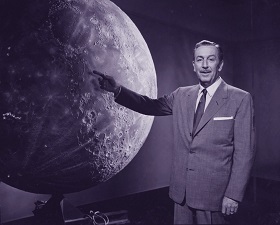
AV: What can we expect for this year regarding Disney history?
DG: There is, as always, a lot on my plate at the moment. In the near term, here is what you can expect: Walt’s People – Volume 14 should be released in March or April this year, with Volume 15 following around December. On February 1, the autobiography of the head of the Walt Disney Music Publishing Company, Jimmy Johnson, Inside the Whimsy Works, will be released by University of Mississippi Press. This is a book I helped edit, along with Greg Ehrbar. I have also just started editing two other “lost” autobiographies: one by Disney Golden Age story artist Homer Brightman and one by Eric Larson, one of the Nine Old Men. All these books (except Jimmy Johnson’s) will be released by Theme Park Press.
There are a few more book projects on my list but it is still a little early to talk about those. I like to keep myself busy and there is little time left to preserve as much Disney history as possible.
is available to order from Amazon.com!
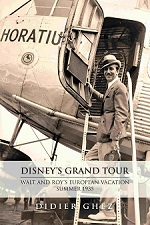
Our thanks to Didier Ghez and Bob McLain at Theme Park Press




